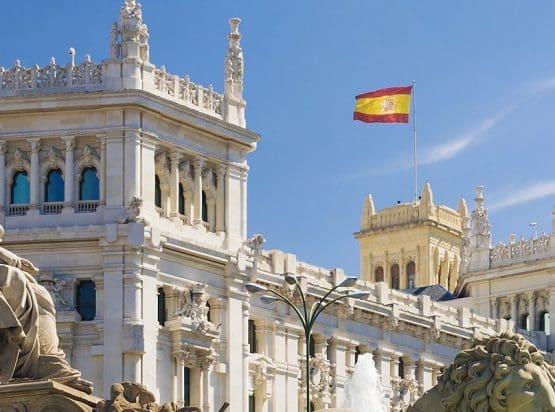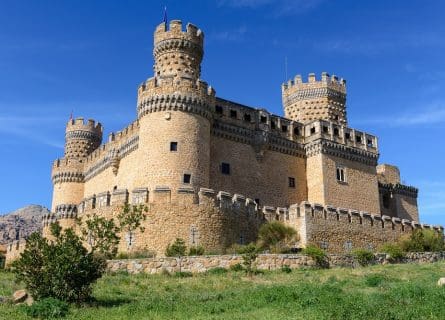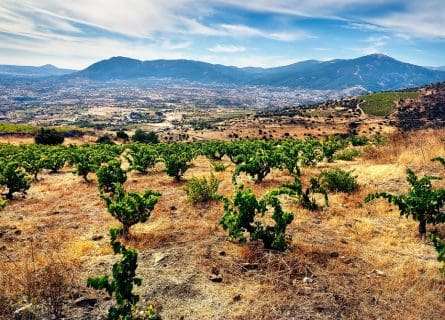Immerse yourself in Madrid's vibrant flavors and uncover hidden culinary gems with our expert insider guides. Plan an unforgettable trip today!
Read more
EXPLORE ALL OUR CASTILLA Y LEON WINE REGIONS GUIDE
Last updated: October 11, 2024
Growers in this region have a knack for producing exciting wines without being unduly expensive, serious without being austere, and utterly drinkable without being obvious. And that’s quite a knack. Yet the vineyards of the Gredos mountains, situated west of Madrid, lack their own DO (appellation). But what is the reason for this gross oversight? Laziness, apathy – a lack of collegiate spirit within the region?
It’s none of the above. Due to internal politics, we may never see the birth of DO Sierra de Gredos, which is a crying shame. Nevertheless, local bodegas have not let that fact stifle their creativity, as they continue to work wonders with Grenache and Albillo Real. Indeed, the granite and slate terroirs of the Gredos mountains yield highly distinctive wines: perfumed, complex, and wonderfully fresh. The best labels have ‘international trophy winner’ written all over them.
Discover more about Spanish Wine

The Catholic church established viticulture in the spectacular landscape of the Sierra de Gredos – monks, to be precise. Yet vines have been cultivated in the Iberian Peninsula since the days of the Phoenicians. This advanced culture arrived in Spain several centuries before the Romans planted their flag in 206 BC.
After mounting a successful campaign against the Carthaginians, a mighty Western Empire was forged in the aftermath – this political union extended from Rome to the Atlas Mountains of Morroco. It endured for over five centuries until Rome was attacked by the Visigothic king Alaric I in 410.
From this point on, Roman authority weakened to the point of absolute dilution. Anarchy and chaos reigned in the late 5th century as rival civilizations fought over the spoils of a decaying Western Empire. Having been pushed into Spain by the Franks, the long-haired Germanic Visigoths established a capital in Toletum (Toledo). But they proved to be no match for the superior forces of the Moorish general Tariq – Arab and Berber mercenaries swept through Spain after the invasion of 711.
Within a few years, central Spain was completely under their control. According to tradition, a Moorish chieftain, Muhammad ben Abd al Rahman, built a fortress above the Manzanares River in the 8th century, which was used to repel the forces of the Christian Reconquista. Known as Magerit, this once provincial backwater would, over the centuries, transform into the glorious city we call Madrid. In 1086, the settlement fell to Alfonso VI of Castile during a campaign to push the Moors out of the peninsula. Retreating to Andalucia, they managed to endure until the late 1400s.
Meanwhile, vines were planted in the neighboring Sierra de Gredos by Cistercian monks attracted to Spain during the reconquest. By the late Middle Ages, these potent wines were highly valued by the court in Madrid; when Felipe II chose Madrid as his capital in 1561, it was a small Castilian town of little real significance.
Yet it would become the nerve center of a mighty empire as Spanish explorers began to colonize Central and South America. Back in the capital, narrow streets and medieval churches grew up on the higher ground behind an old Arab alcazar, eventually replaced by the present Bourbon palace, the Palacio Real, in the 18th century. The preceding Habsburg dynasty was no less grandiose in its architectural ambition, building royal monasteries and private palaces.
However, turmoil and decline gripped the Spanish state during the 19th and 20th centuries. The residents of Madrid rose up against Napoleon’s invasion in 1808, attacking French troops stationed around the Palacio Real and Plaza del Dos de Mayo.
The upheaval of the Carlist Wars was compounded by Spain’s loss of its former colonies, while the advent of the railway did no favors to winegrowers in the Sierra de Gredos; rail links to the much cheaper wines of La Mancha saw demand plummet. The arrival of phylloxera in the late 1800s was the final nail in the coffin – production continued to decline until the latter part of the 20th century.
Then, a new generation of ambitious winemakers arrived – like Fernando Garcia, Telmo Rodriguez, and Daniel Ramos. Seduced by the abundance of old bush vines, this firmament now crafts some of Spain’s most terroir-expressive and ethereal reds and some spellbinding whites based on Albillo Real.

This great mountain range, west of Madrid, is justly celebrated for its captivating scenery and majestic fauna. The slopes on the range’s south side, extending into Extremadura, are fertile and sheltered, with pinewoods, apple, and olive trees. Yet the northern slopes, defined by their granite and slate boulders, offer impoverished soils indeed. Here, you’ll find scattered parcels of old bush vines – the remnant of a once thriving region. Slowly but surely, the industry is being rebuilt. The winegrowing area is divided between three valleys, each with its own macroclimate and unique growing conditions.
Unique Soil Composition
Soils are a mixture of granite, quartz, silt, and slate – winemakers believe that vines grown on schist terroir will yield very distinctive wines from the more common granite. The consensus is thus: Granite-based wines are more linear, fresh, and floral; slate terroir gives a more potent, intense expression of the Grenache grape.
Moreover, weather can vary dramatically within the same region with many elevations and aspects. Indeed, a sheltered slope may be bathed in warm sunshine, while a less fortunate climat – or fortunate, depending on your point of view! – is experiencing a deluge. Nevertheless, while there is no shortage of rain overall, summers can be very hot and dry.
This is where altitude comes in. Specific vineyard sites rise over 1200 meters above sea level, encouraging significant diurnal temperature variation. This makes all the difference in torrid weather; the temperature can be 95°F in the midday August sun, falling to under 61°F at 11 pm. As a result, the vine stops producing sugar, and the acidity in the berries can reassert itself.
Much of the acreage is also managed according to organic and biodynamic principles, while the yield is often less than 30 hectoliters per hectare. Such economics are only viable if the critical mass pulls in the same direction, fashioning premium wines that punch above their price point. Fortunately, there are some exceptionally talented winemakers working in Gredos today.
These remarkable wines actually qualify for one of four appellations: Vinos de Madrid, Cebreros, Méntrida, and Vino de la Tierra. Yet many producers belong to the Cebreros DO, a very young appellation created in 2019. Located south of Avila, it is blessed with some of the finest terroir in the Sierra de Gredos – vines are planted on both sides of the mountain range.
As a rule, bodegas do not trouble themselves with endless experimentation, playing with varieties that have no business there. Instead, they continue searching for the best terroirs for the region’s two signature grapes: Garnacha Tinta and Albillo Real. In addition, small amounts of Godello, Carignan, Listán Negro, and Verdejo planted – field blends are fairly common in certain parts of the region. Garnacha Tinta, however, is the real star of the show.
Garnacha Tinta in Gredos
This once-maligned variety is treated with great reverence in Gredos. Critics often describe top Spanish Grenache as “Pinot Noir-like” due to its relatively light color and red berry bouquet. Most growers conform to this paradigm: few desire heavy extraction or alcohol in their wines. The best of Sierra de Gredos offers crystalline fruit and expressive aromatics, with new oak kept at a minimum.
Yet the range of equipment used can vary considerably – you’ll see concrete and stainless steel tanks, amphorae, concrete eggs, and large vats in these cellars. Some winemakers like to include a certain percentage of stems in the tank; others abhor the practice, arguing that it encourages green tannins.
However, a stylistic coherence defines the vast majority of Grenache wines produced here. Gently and deftly made, they are beautifully aromatic and very fine, with notes of raspberry, garrigue, violets, and fennel – gloriously and unashamedly Burgundian.
Gredos whites are no less impressive. Typically based on Albillo Real, a growing number of wines are treated to a period of skin contact, adding layers of structure, grip, and complexity to a grape that, until recently, was dismissed as hum-drum. The best of this firmament showcases exotic honeysuckle, jasmine, citrus, and apricot notes with a vibrant orange-peel finish. “A food wine” in every sense of the word.

The subject of Grenache can be highly divisive among wine lovers. Memories of alcoholic dross have not yet faded for some collectors; its ubiquitous role as cheap blending material in the 20th century did the grape’s image no favors. And, while individual labels like Palacios’ L’Ermita sell for impressive prices, these are the exception rather than the rule.
The crux of the issue is misapprehension: the mere mention of the word Grenache invokes expectations of jammy fruit and high-alcohol red wines – about as subtle as a fluorescent Ferrari. Granted, some winemakers cheerfully reinforce this stereotype.
Elegance and Versatility
Yet, as Telmo Rodriguez and Daniel Ramos have proven, Grenache has many sides to its personality. Savory tannin, fresh acidity, and elegance are all attributes that make wines go temptingly and digestibly with food. The signature variety of Gredos can be delivered in spades, producing wines as ethereal and understated as any Pinot Noir from the Cote de Beaune.
But why here? Why has the Sierra de Gredos enjoyed such a notable success rate with this mercurial grape? Many would say it’s due to an advantageous combination of terroir and climate – soil and situation. The metamorphic soils found across these glacial valleys are rich in minerals, although granite and slate are not unique to the vineyards of the Gredos mountains.
The area is also blessed with numerous high-altitude sites and old bush vines, again, two important ingredients that can be found elsewhere. Still, encountering so many favorable attributes in one region is rare. And, even more remarkably, this recherché vineyard has managed to attract the best and brightest of Spain’s top winemakers: the elite of the elite.
Signature Style
Add everything up, and you’re left with a formidable force in the world of fine wine. Bodegas who work in the Sierra de Gredos make life easy for oenophiles; it has a signature style. The range of grape varieties marketed is smaller than Navarra, and Garnacha is the mainstay of red production. This is good news for consumers seeking affordable, brilliant, elegant, juicy wines with plenty of fruit.
Meanwhile, Albillo Real is making the transition from super-niche to sommelier favorite. The more famous appellations and regions may hog more international limelight, but they should not be complacent. Gredos is winning critical pundits left, right, and center – and the applause is getting louder. It’s only a matter of time before consumers are won over, too.
Exploring Albillo: Spain's Versatile Wine Grape in Ribera del Duero, Madrid, and Galicia. Uncover the Diversity of this Remarkable Varietal.
Find out moreDiscover Godello: Galicia's Exquisite White Wine Grape from Valdeorras. Unveiling the Delights of this Northwestern Spanish Varietal.
Find out moreUncover the allure of Marsanne grape variety. From its traditional role in Rhône blends to the new wave of single-varietal Marsanne wines.
Find out moreDiscover Viura: Rioja's Prominent White Grape & Catalonia's Macabeo. Explore its versatility in exquisite wines. A must-read for wine enthusiasts.
Find out moreLearn about Roussanne, the elegant white grape native to Rhône. Often blended with Marsanne, explore its unique qualities and rich heritage in our guide.
Find out moreUnveiling Verdejo: Spain's Rueda Wine Region's Prized White Grape. Explore the Crispness and Lightness of this Dry White Varietal.
Find out moreGarnacha: Spain's Red Gem. Akin to Pinot Noir, it bridges terroir and winemaking, crafting captivating expressions.
Find out moreThe Listán Negro grape is an indigenous variety found in the Canary Islands. Its origins trace back to Spain's colonial past, and it has adapted to the unique volcanic terroir and coastal influences of the islands. Listán Negro produces diverse wines, ranging from light and fruity to robust and complex.
The restaurants of Madrid are a rich source of specialties from every Spanish region, served in destinations that range from the palatial to rustic; you can dine like a Bourbon monarch in the city’s numerous Michelin-starred venues or soak up the atmosphere of a buzzy tapas bar in Lavapies. Game, such as wild boar, pheasant, and partridge, is plentiful in the fall and winter; roast suckling pig and milk-fed lamb are heaven paired alongside a glass of Sierra de Gredos red.
If you would like us to customize an exclusive luxury tour, contact us and let us know your travel plans. We offer luxury food and wine tours for private groups of a mininium two guests. In addition, all of our private, chauffeured tours are available year-round upon request.

